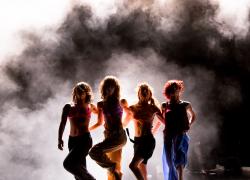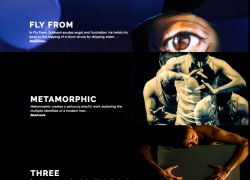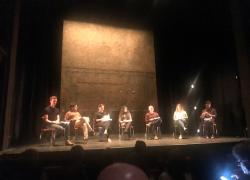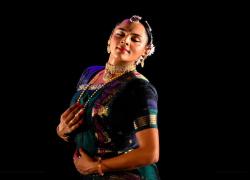The Great Indian Musical – Civilization to Nation
The Great Indian Musical – Civilization to Nation
Written and directed by Feroz Abbas Khan
Nita Mukesh Ambani Cultural Centre
Mumbai
2 October 2023
Reviewed by Sanjeevini Dutta
Image: Screenshot from NMACC promotional video
The title suggests it: this is a ninety-minute high octane production, the scale of which has never before been witnessed on an Indian stage. In the glittering new 2000-seat theatre within the Ambani-owned complex, the nation on the rise projects its confidence and sheer sense of self-belief. Patroness Nita Ambani declares in her closing speech that Indian civilization is ancient and glorious and is, in Mark Twain’s words, ‘where it all began’.
The show opens with the striking of the Naad in the form of the sacred syllable Om – the Dolby surround sound kicks in with an up-tempo score and burst of lighting, the reflective disco ball spots are set in motion. The pin-prick projected light expands as a group of dancers perform a solemn vandana (opening prayer). Within a few moments a monumental Ganesha is lowered, as the stage fills with dancers holding divas, or brass thalis or three tiered light holders, who burst on to the stage; drums beat, clappers strike and fifty or so dancers, women in red and men in white, fill the stage with movement, sound and colour. It is a spectacular display of skilled dancers, rich and ornate projections and enveloping sound. The speed and seamless changes of formations does not allow a loose moment – each second is action-filled. The spectacle is breath-taking and the audience gasps. Spontaneous applause breaks out in the auditorium.
In terms of the civilizational milestones we are taken through the Ramayana and the message of the Bhagavad Gita; the Mahabharata and ensuing destruction; Jainism, Buddhism; the Bhakti movements in the form of Mira Bai and her devotion to Krishna; Sikhism, the Mughal era, before we are introduced to the Freedom fighters on the path to achieving Independence.
Through the sections, one of the most visually striking is the Battle of Kurukshetra. Here the martial arts come to the fore: the sword display of the Sikhs, the leaps of the Manipuri drummers and the kalaripayattu low crouches with springing high kicks. Archers mounted on the shoulders of fellow fighters take aim with bows and arrows and horses gallop across the stage. The action is further enhanced by projections of silhouetted warriors on the screen engaged in battle.
In the concluding section the battle formation of the chakravyuha in which Abhimanyu, the son of Arjun is trapped and ultimately killed is poignantly evoked. The scene brings to mind the work of Ratan Thiyaam of the Manipuri Theatre Company. The choreographers excel in this section, highlighted by the use of props – the fluttering banners and spinning umbrellas vibrate with energy and dynamism.
The use of stage design in the form of projections is perhaps most striking in the Mughal section. The close-up detail of a single tile of jali-work (filigreed tracery) is expanded to create full walls framed by delicate arches and then the palatial view of a three-level deep series of arched doorways. The art direction here is splendid! The large group of kathak dancers performing to a tarana dressed in blue and white is another sight to behold. Sometimes gathered in a tight circle which then loosens and expands in multiple directions; sometimes it becomes a wave, then a river branching out in a tree-like shape. The formations are kaleidoscopic. The speed and precision of chakkars (pirouettes) with the flared skirts ballooning out is another visual treat.
Another strong section is the vocal rendition of a shabad (sacred text from the Adi Granth, the sacred scripture of Sikhism), an abhang (devotional song from Maharastra) and Sufi kalam (devotional song) ‘Chaap, tilak’ by three female singers against the illuminated outlines of a gurdwara, mandir and masjid – a wonderful testament to the religious tolerance of India. To be fair, the Mumbai audiences responded with the loudest claps to the Sufi singing!
As we move to the Independence era we see the black-and-white footage of Mahatma Gandhi leading the Salt March, or in his Ashram with his charkha (spinning wheel). Outside, lathi-beating forces lay into protesters, a sombre reminder of how hard-won freedom has been. The key figures of the Independence movement are honoured: Sardar Vallabhai Patel, Rabindranath Tagore, Dr Babasaheb Ambedkar. The secularism espoused in the Indian constitution is reiterated and celebrated. This is a positive message at a time when even the sanctity of the Constitution is not guaranteed.
On the whole, The Great Indian Musical is a huge commercial success, with high production values and plenty of gloss to make an attractive package, a box of delights. The skill and technical ability of the artists is not in question. The values that the production serves, however, is the acceptance in our current times of money and success as king. The irony of the ‘naked fakir’, the Father of the Nation, being feted by the bastion of capitalism creates the enigma of where each of the viewers stands in this equation. On the one hand, the show brings work and profile to writers, singers, dancers and technical professionals; on the other hand artists bow down to the power of mighty corporations and their political allies. Each individual must answer to their own conscience.
CREDITS
Ajay-Atul (Music)
Vaibhavi Merchant and Mayuri Upadhyay (Choreography)
Manish Malhotra (Costume)
Donald Holder (Lighting design)
Neil Patel (Stage & Scenic Presentation)
Gareth Owen (Sound Design)
John Narun (Projection)



















